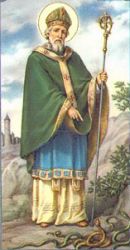 Happy Saint Patrick’s Day! Being part Irish, I thought it fitting to share a bit with you all about the the historical person whose memory we celebrate every March 17th, the traditional Feast Day of Saint Patrick. For non-Catholics, the “Feast Day” of any saint is the anniversary of the month and day of his or her death or martyrdom.
Happy Saint Patrick’s Day! Being part Irish, I thought it fitting to share a bit with you all about the the historical person whose memory we celebrate every March 17th, the traditional Feast Day of Saint Patrick. For non-Catholics, the “Feast Day” of any saint is the anniversary of the month and day of his or her death or martyrdom.
The Two Patricks: Interestingly, there are scholars who have suggested the “Theory of the Two Patricks”, suggesting that the person we know as Saint Patrick, was actually the amalgamation of two separate historical figures, however, I will simply share the story of Saint Patrick in regards to the aspects of his life which have become most accepted in modern history.
Birth Name of Patrick: The birth name of Patrick was originally Maewyn Succat, which translates as “May-born Warrior”. (Mae, “Born in the 5th Month”; Wyn, “Joy”; Succat, “Warlike”.)
Birth and Youth: Saint Patrick was allegedly born in Wales (some say Scotland, but his name belies a connection to the Welsh traditions) approximately between the years of 385-390 AD. Maewyn was born, and lived as a Pagan, for the first part of his life.
Legend has it that at the age of 16, he was kidnapped by a group of Irish marauders who raided his village, and was subsequently sold into slavery. It was during the time of his captivity as a slave that he first sought refuge in the idea of the God of the Christians.
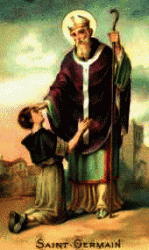 Religious Orders: At the age of 22, Maewyn escaped from slavery and journeyed to Gaul, where he entered a monastery run by the Bishop of Auxerre, Saint Germain (not to be confused with the person known as Count Saint Germain.) Maewyn stayed at the monastery, studying for 12 years, during which time he came to the realization that his “calling” was to convert the Pagans to Christianity.
Religious Orders: At the age of 22, Maewyn escaped from slavery and journeyed to Gaul, where he entered a monastery run by the Bishop of Auxerre, Saint Germain (not to be confused with the person known as Count Saint Germain.) Maewyn stayed at the monastery, studying for 12 years, during which time he came to the realization that his “calling” was to convert the Pagans to Christianity.
The Calling: Maewyn decided he wanted to start his lifelong mission by returning to Ireland, however his religious superiors at the monastery chose to charge Saint Palladius with the task instead. Within two years’ time, Palladius was transferred to Scotland, leaving Maewyn to become the second bishop appointed to Ireland. During his time at the monastery, Maewyn had adopted the Christian name of Patrick (meaning, “Noble”.)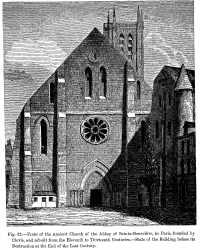
Life as a Bishop: Upon his appointment as Bishop of Ireland, Patrick began living his mission of converting a great number of Pagans to Christianity, infuriating a particular group known as the Druids of Wicklow Head, who occupied Ireland at the time. In an effort to stifle his success, Patrick suffered through a series of arrests at the hands of the Druids, but managed to escape every time.
Once freed, Patrick the next 30 years roaming Ireland, establishing schools and monasteries throughout the entire country, thus enabling his relatively speedy conversion of the Irish to Christianity.
End of Life: After retiring from his active work of conversion, Patrick retired to the town of Saul, County Down, where he died on March 17th, sometime between the years of 461-464 AD (according to various legends). Since that time, people around much of the world have continued to celebrate the life and work of Patrick, who has become known as the Patron Saint of Ireland.
The Canonization of Saint Patrick: Strangely enough, Saint Patrick has never been formally canonized by any Pope of the Catholic Church! This is because for most of Christianity’s first thousand years, canonisations were done on the diocesan or regional level.
Ordinarily, soon after the death of people considered to be very holy, the local Church affirms their ability to be liturgically celebrated as saints. Since there has never been a formal affirmation by the Catholic Church, as a result of this bizarre oversight, Saint Patrick has never received a formal decree of his Sainthood!
All that aside, the lack of an “official” declaration of his sainthood, has done little to affect his popularity with millions of us who remember him, and continue to celebrate his feast day! Saint Patrick — “This Bud’s for you!”
The Lore of Saint Patrick: A great deal of Irish folklore and superstition continues to surround St. Patrick’s Day, although a great deal of this lore has never been actually substantiated.
Resuscitation of the Dead: During his life, Patrick reputedly raised people from the dead, although there are no official reports to substantiate this claim;
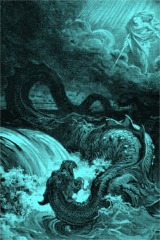 The Banishing of the Serpents: Most famously, Patrick was said to have “driven all the snakes out of Ireland” by the power of one of his sermons. However, science has proven that snakes have never been native to Ireland. In particular, one serpent supposedly banished from Ireland by Saint Patrick was, Caoránach. Legend has it that Caoránach was a dragon monster, said to be the mother of demons and devils. There are others who believe that this is a metaphor for Patrick’s conversion of the Pagans.
The Banishing of the Serpents: Most famously, Patrick was said to have “driven all the snakes out of Ireland” by the power of one of his sermons. However, science has proven that snakes have never been native to Ireland. In particular, one serpent supposedly banished from Ireland by Saint Patrick was, Caoránach. Legend has it that Caoránach was a dragon monster, said to be the mother of demons and devils. There are others who believe that this is a metaphor for Patrick’s conversion of the Pagans.
Saint Patrick’s Feast Day, a Global Celebration: Saint Patrick’s Day was originally celebrated as a Catholic Holy Day, however, the saint’s Feast Day has since become more of a secular holiday, celebrated by people from all faiths.
The Shamrock, Symbol of Saint Patrick: The traditional icon of Saint Patrick is the Shamrock, (called “Copóg Phádraig”, Gaelic) a clover leaf, which usually is made of 3 separate leaves. Ancient uses of the clover leaf was to protect one from the mischief of Fairies.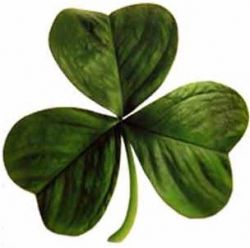
Inasmuch as Saint Patrick is concerned, the significance of the Shamrock clover was used as a way to explain the divinity of the Trinity of the Christian faith. He used the Shamrock symbol to explain the esoteric idea of the “Father, Son and the Holy Spirit”, as one being with separate functions. To this day, Catholics and other followers of the saint wear a Shamrock in his honor, upon his Feast Day.
Saint Patrick’s Day in America: The custom of celebrating Saint Patrick’s Day, arrived in America in 1737. That was the year which the Feast Day of Saint Patrick was first celebrated in America, in Boston, Massachussetts.
People continue to celebrate Saint Patrick’s Day by holding parades, the “wearing of the green”, and drinking beer (sometimes green!)
Pagan Origins of Saint Patrick’s Day: It has been noted by many that Saint Patrick’s Day has become the Church’s way of allowing people to celebrate the Vernal Equinox (the birth of Spring) with the symbolizing of the color green, as well as the acceptance of the wild reveling of people at this time of the year as the “party time” of Spring Break arrives. Interesting timing, hmm?
Saint Patrick Links: To find out more about this fascinating and much-loved historical figure, feel free to check out the links on the Voxx Magickal Forum, in the Saint Section.